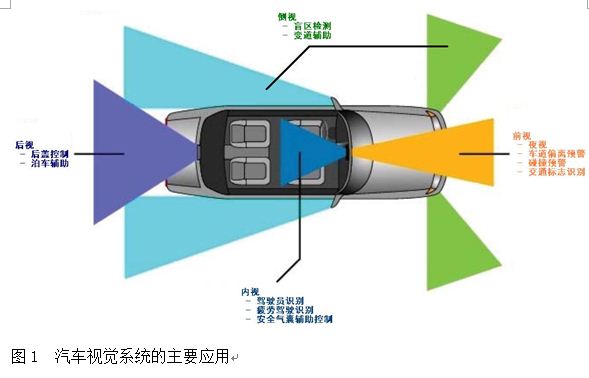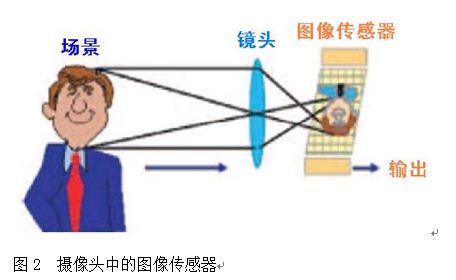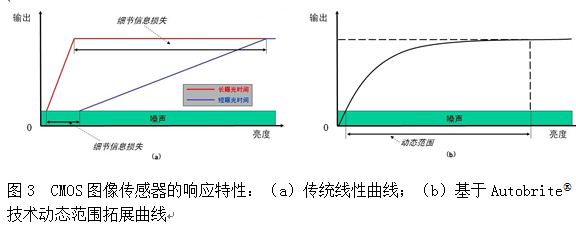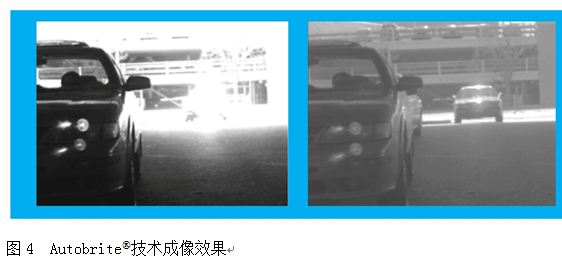1 Introduction This article refers to the address: http:// With the importance of car safety, the Driving Assistance System (DAS) is becoming more and more widely used in the automotive field. In such applications, the graphical vision system is an integral part of the need to quickly and accurately sense various road conditions and to alert or control vehicle behavior in advance. This requires the front end of the system - the camera can be adapted to different lighting conditions to provide maximum details of the road scene. Figure 1 shows the main applications of the automotive vision system, including front, rear, side, and interior. In the past, applications such as Night Vision (NV), Lane Departure Warning (LDW), Collision Warning (CW), and Traffic Sign Recognition (TSR) require visual systems. Under various weather and road conditions, lane lines, vehicles, obstacles, traffic signs, etc. can be clearly identified. All of these features require the image sensor 's Dynamic Range (DR) to be high enough to provide rich detail information for the post-level image processing system. This article focuses on the application of image sensors in automotive vision systems. The second part introduces the requirements of the automotive vision system for image sensor performance, and the third part discusses the high dynamic range image sensor technology. The fourth part gives a summary of this article. 2. Image sensor in automotive vision system An image sensor is a device that converts an optical image into an electronic signal and is an important component of the camera, as shown in Figure 2. In typical automotive applications, the vision system has to deal with complex road conditions, such as facing the sun, entering and leaving the tunnel, and facing the vehicle headlights at night. This kind of road condition requires the camera and the image sensor therein to automatically adapt to such complex scenes, otherwise the loss of detailed information in the image is difficult to recover by the post-stage signal processing method. In a picture, the ratio of the brightness of the brightest part to the darkest part is called the dynamic range. For example, the brightness of a bright object under direct sunlight is about 100kcd/m2, and the brightness of a dark object under shadow is about 100mcd/m2. If a scene includes both objects, the dynamic range of the image is 120 dB. Only when the dynamic range of the image sensor is higher than 120dB, the car vision system can effectively image the scene. Considering driving at night, some roads have no street lights or street lights are very dark, and the car vision system also needs to collect road condition information in low-light scenes. For automotive applications, image sensors need to meet a range of automotive-grade requirements such as wide temperature range, high reliability, high integration, and low cost. Table 1 summarizes the performance that an image sensor should have in an automotive vision system: 3. Melexis high dynamic range image sensor technology Due to the high integration, high stability and low cost of CMOS technology, CMOS technology-based image sensors are becoming more and more widely used, and have become the first choice for most vision systems. The CMOS image sensor includes a photodiode that produces a photocurrent that is positively correlated with light intensity under illumination excitation. By integrating the photocurrent over a certain exposure time, the optical image signal can be replaced by the electronic signal output of the pixel, and its response characteristics are as shown in Fig. 3(a). Because of the power supply voltage amplitude and sensor noise limitations, the dynamic range and imaging details of conventional CMOS image sensors are a contradiction: increasing the exposure time can improve the detail but at the same time reduce the dynamic range. Conversely, reducing the exposure time can improve the dynamic range but is not conducive to detail display. . The main contradiction in the traditional CMOS image sensor makes it impossible to fully meet the requirements of the automotive vision system. In response to the characteristics of CMOS technology, Melexis developed the CMOS image sensor MLX75412 based on Autobrite technology, and solved the above contradiction with the nonlinear response characteristic shown in Fig. 3(b), which greatly improved the dynamic range of the image sensor and made it conform to Table 1. All standards listed. The segmentation exposure/reset control of the pixels is performed by Autobrite technology, and the dynamic range of the image sensor is extended to 154 dB. The integrated feedback control algorithm analyzes the acquired images and adjusts the exposure time and dynamic range of the sensor in real time, which significantly improves the quality of image acquisition under complex road conditions. The MLX75412's integrated image enhancement, Autoview, adjusts image brightness and sharpness in real time, reducing the amount of computation in the post-processing system. At the same time, due to the 12-bit image processing pipeline integrated in the MLX75412, the image processing accuracy is higher than the commonly used 8-bit image processing. The MLX75412 provides standard raw video signal output and I2C control signal input, compatible with most DSPs or FPGAs. Considering automotive applications, the MLX75412 offers a widescreen image of 1024 x 512 resolution for a wider range of images, making it easy to identify pedestrians or traffic signs on both sides of the road. Figure 4 compares the imaging effects of a conventional CMOS image sensor and an image sensor based on Autobrite technology. In Figure 4(a), because the dynamic range of the sensor does not effectively adapt to the dynamic range of the scene, the details of the dark and bright areas of the image are poor. In contrast, by using the Autobrite technique, the image shown in Figure 4(b) has good detail for both bright and dark areas. For applications such as lane departure warning and obstacle recognition, the details in the high dynamic range image can greatly improve the accuracy of the driving assistance system. 4 Conclusion This paper analyzes the need for image sensor performance in automotive vision systems. The operation of a car vision system depends on its front-end—the ability of the camera to capture image information, which is largely determined by the image sensor. In order to capture scene details under complex road conditions, the sensor must have a high dynamic range and high sensitivity. Considering automotive applications, it must have high reliability, high integration, and high flexibility. The Melexis MLX75412 is a high dynamic range CMOS image sensor based on Autobrite technology for automotive vision systems applications. Autobrite technology captures high-quality images in complex road conditions with widely varying brightness levels, providing accurate and reliable scene detail information for driving assistance systems, thereby improving driving safety.
We are Manufacturer and Supplier to offer Modular Plugs in standard configurations to terminate modular cords for patching or work area applications. Our Modular plugs can be terminated to the exact cable length needed in order to maintain a neater, more organized installation. The modular plugs terminate twisted-pair cable with 26 - 22 AWG (0.40mm - 0.64mm) solid or 7-strand conductors with an insulated conductor diameter of 0.86 - 0.99mm (0.034 - 0.039 in.). All modular plug contacts have 50 microinches minimum of gold plating over nickel and meet TIA-968-A and IEC 60603-7 specifications.
Modular Plug is the name given to a family of electrical connectors originally used in telephone wiring and now used for many other purposes. Many applications that originally used a bulkier, more expensive connector have now migrated to modular connectors. Probably the most well known applications of modular connectors are for telephone jacks and for Ethernet jacks, both of which are nearly always Modular Connectors.
Modular Connectors were originally used with the registered jack system, which precisely describes how the connectors are wired for telecommunications. The registered jack specifications define the wiring patterns of the jacks, not the physical dimensions or geometry of the connectors of either gender. Instead, these latter aspects are covered by ISO standard 8877, first used in ISDN systems. TIA/EIA-568 is a standard for data circuits wired on Modular Plug&Connectors.
Modular Plugs RJ45 Modular Plugs, RJ11 Modular Plugs, AMP Modular Plugs, Modular Connector, Cat6 Modular Plugs, Cat5e Modular Plugs NINGBO YULIANG TELECOM MUNICATIONS EQUIPMENT CO.,LTD. , https://www.yltelecom.com




